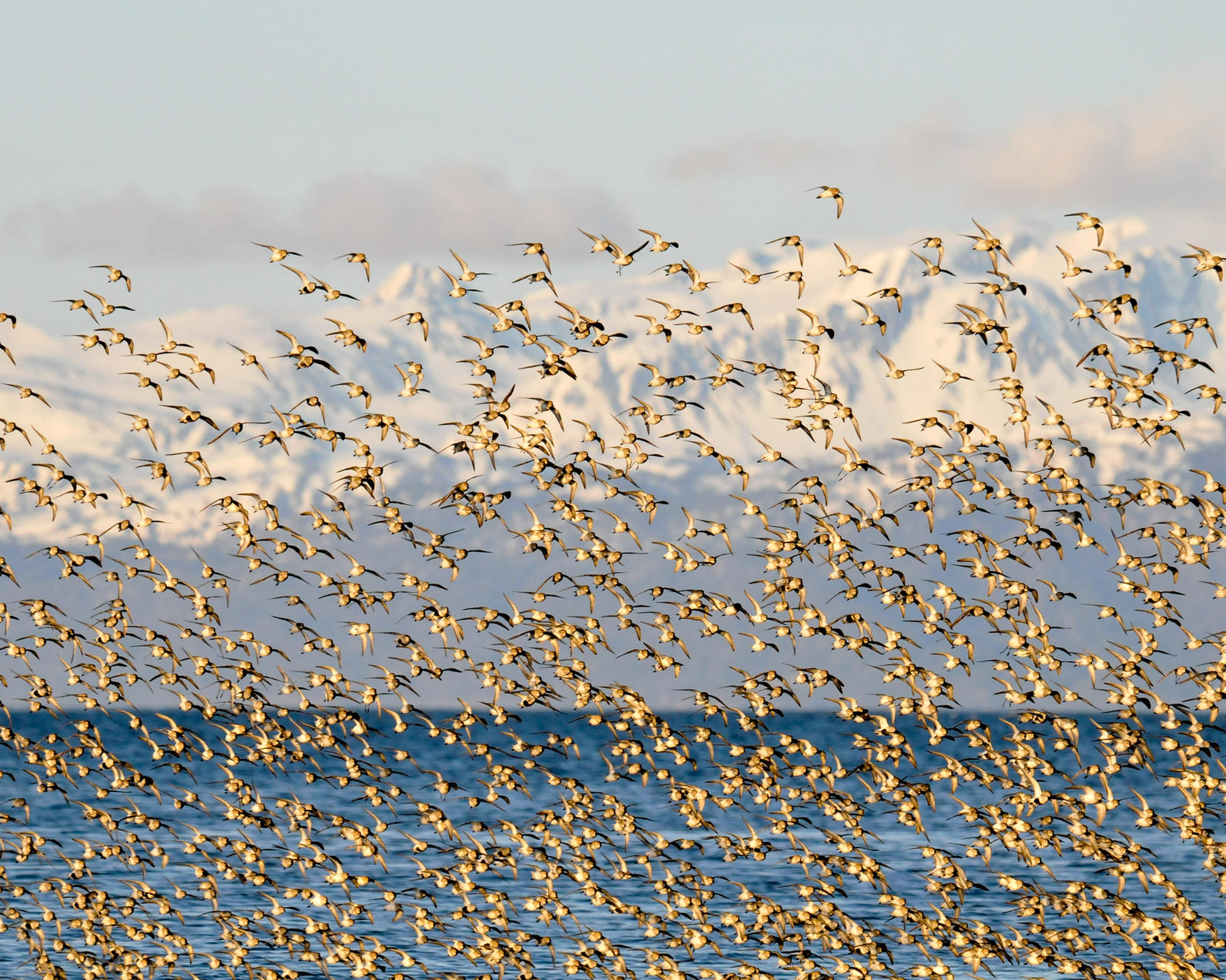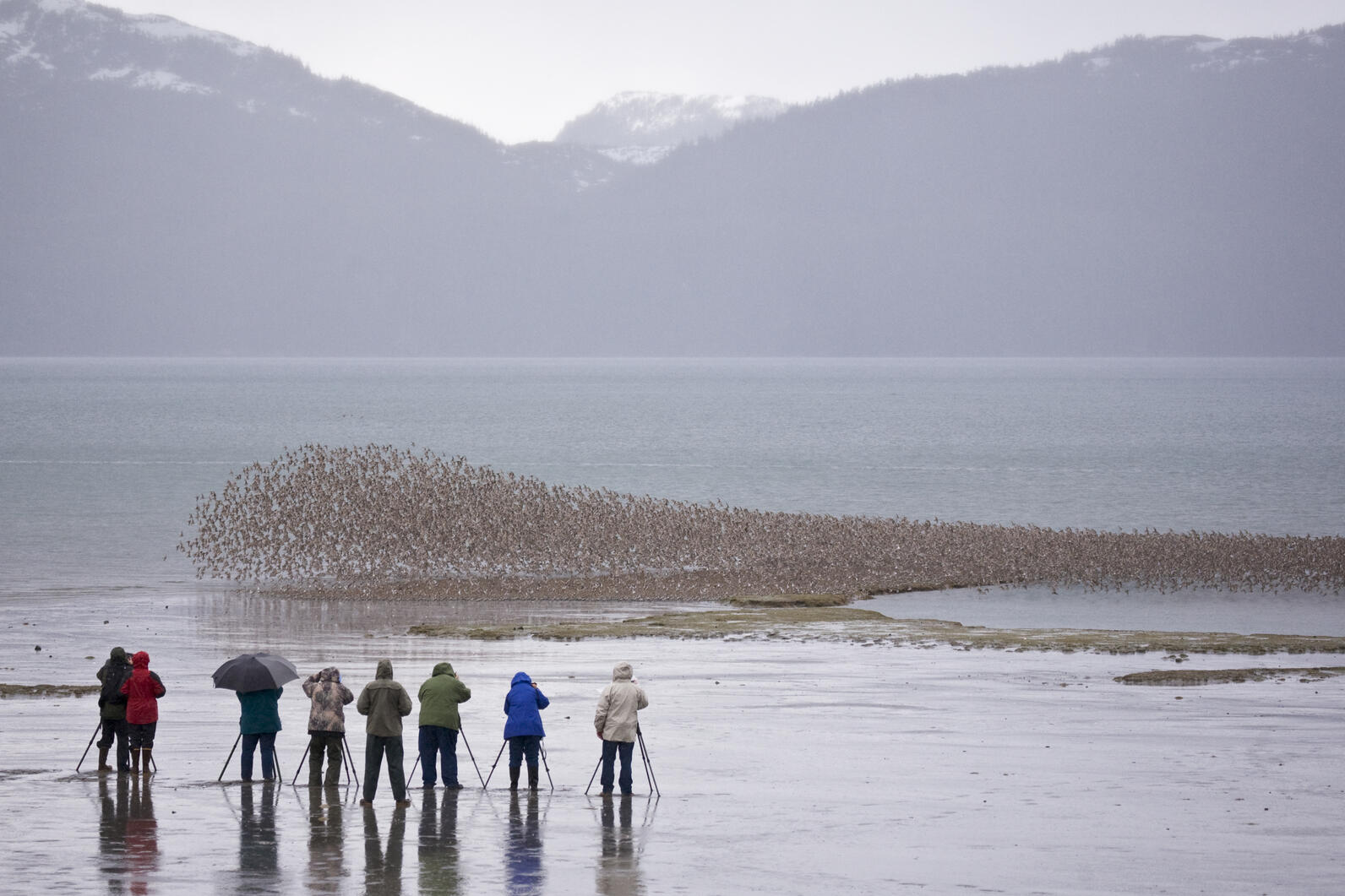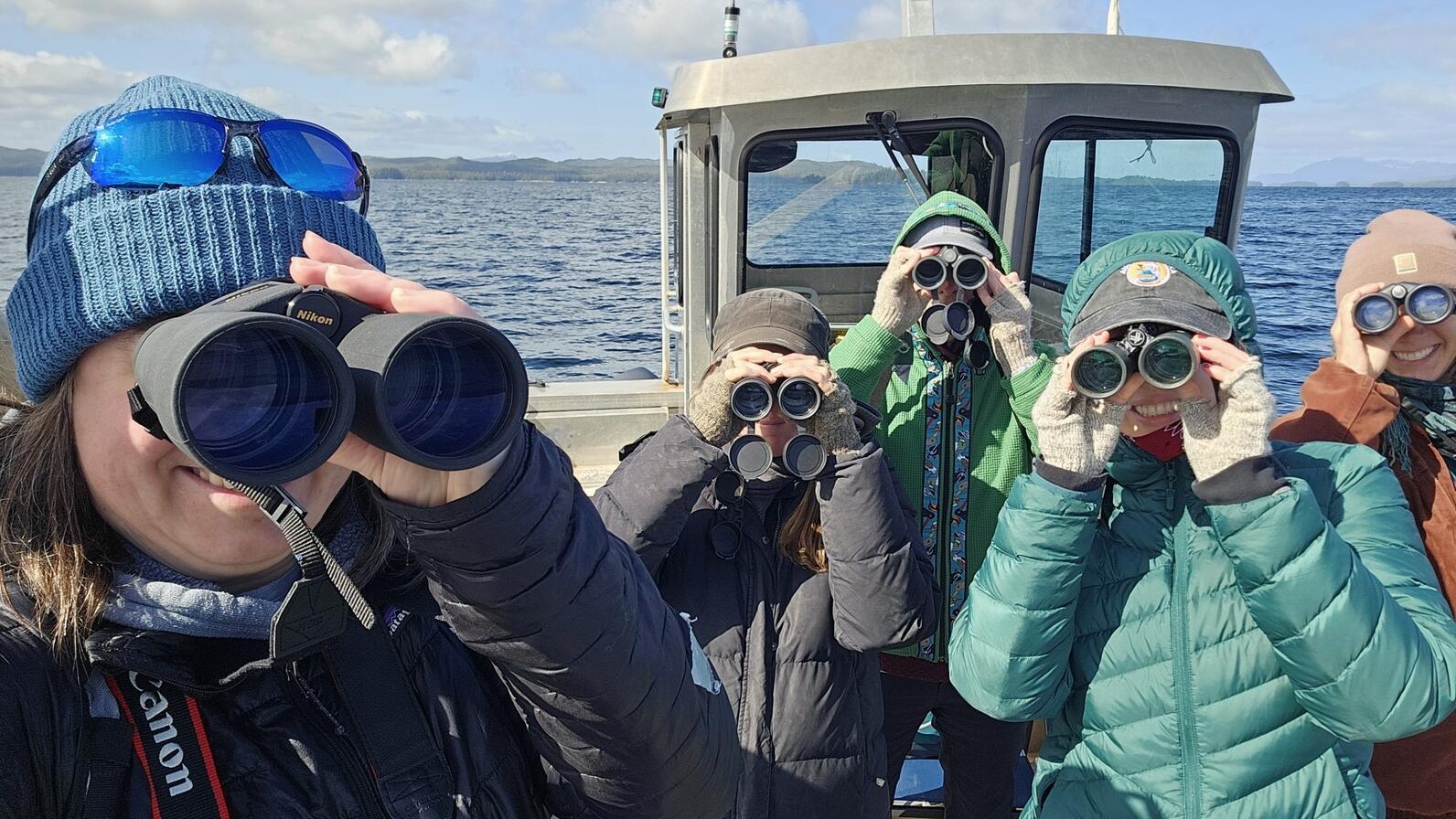Imagine hosting a bird-themed party as the world’s largest concentration of shorebirds and a global breeding hotspot for hundreds of migratory species. Oh, and you’re also a global destination for birders because of off-the-charts spring and fall migrations.
That’s the kind of pressure Alaska’s bird festivals are under every year.
Luckily bird-focused events here easily rise to the occasion thanks to dedicated organizers, schedules packed with only-in-Alaska experiences, cultural programming, community participation, and above all (literally) the birds.
First, we’ll prove that bird tourism is not only a thing but a huge deal. People flock in to bird and learn about birds, but they’re also racking up the bill. Then we’ll break down how these festivals underscore bird and habitat conservation while also boosting tourism, spotlighting local artists, and celebrating Alaska Native culture.
By the Numbers
To put it plainly, birding—and bird tourism—is hot right now.
To put it specifically, a recent survey from the United States Fish and Wildlife Service found that in 2022, 148.3 million United States residents, or 57% of the U.S. population aged 16 and older, participated in wildlife-watching activities. Yes, more than half of the U.S. population 16 and over were “closely observing, feeding, or photographing wildlife, visiting public parks around the home to view wildlife, and maintaining plantings and natural areas around the home for the benefit of wildlife.”
And of all the wildlife in the United States, birds were the most popular.
“Approximately 96.3 million people observed birds around the home and on trips in 2022,” the study reads. “A large majority, 95 percent (91.1 million), observed wild birds around the home, while 44 percent, 42.6 million, took trips away from home to observe wild birds.”
And there’s great data for birding-related travel.
About 146.5 million watched wildlife around the home while 73.3 million people took trips to view wildlife. And 63% of wildlife-related recreation dollars spent in 2022 was for wildlife watching. All in all, wildlife watchers spent $42.1 billion on trips pursuing their activities.
Also in 2022, the study “Small sight-Big might: Economic impact of bird tourism shows opportunities for rural communities and biodiversity conservation” was published, a report on birding tourism specifically in Alaska. It found that in 2016, nearly 300,000 birdwatchers visited Alaska and spent $378 million, supporting approximately 4,000 jobs. And let’s just say that the amount of tourists has hit record numbers since. This study demonstrates that birders bring economic resources to remote Alaskan communities while “diversifying their economies and contributing to biodiversity conservation in areas of bird habitat with global significance.”
While numbers have a great way of telling a story, many of the organizers and artists behind Alaska’s bird festivals can tell it better.

For the Birds
This will be the fourth year Melanie Dufour (Program Manager for Friends of Alaska National Wildlife Refuges) is organizing the Kachemak Bay Shorebird Festival from May 8 to 12, 2024. This southcentral Alaska event is designed to celebrate the return of migratory birds to the bay’s mudflats and rocky coastal areas of the Homer Spit.
“Homer’s mud flats and Kachemak Bay are now considered ’critical habitat’ and a part of the Western Hemisphere Shorebird Reserve Network,” Dufour says. “During the festival, people of all ages and abilities have opportunities to learn about the birds and their habitat and why conservation of that environment is important and can be accomplished if we all care.”
Yes, because many of these festivals don’t just focus on birds, but also vital bird habitat.
As mentioned, Alaska lands support the world’s largest concentration of shorebirds. We’re a global breeding hotspot for hundreds of migratory species, including many of concern due to population decline. So Alaska has a unique opportunity to truly link bird conservation and bird tourism, and this can be done in part through bird festivals.
Bird festivals like the 34th annual Copper River Delta Shorebird Festival in Cordova from May 3 to 5, 2024.
“The festival promotes education and partnerships for enhanced environmental awareness and good stewardship of the National Forests of Alaska,” says Cathy Renfeldt, Executive Director of the Cordova Chamber of Commerce. “Through a diverse and scientifically sound program, the festival improves agency and public awareness and appreciation of terrestrial communities and species and ecosystems of concern not only for what they may provide in economic support to local and global communities but also for their role in maintaining ecosystem function and ecosystem services.”
Renfeldt says it’s important to raise public awareness of the Chugach National Forest and Copper River Delta as critical stopover sites for migrating shorebirds from North and South America. And by critical, she’s referring to the fact that the Copper River Delta is the largest contiguous intact wetland on North America’s Pacific Coast and is also deemed “of hemispheric importance” by the Western Hemisphere Shorebird Reserve Network (WHSRN).
Millions of shorebirds migrate to the area each year, and attendees of this community-driven event—the first birding festival in the state of Alaska—will be there waiting for them.
Not too far away (or at least on the Alaska scale), Yakutat is prepping for its 13th annual Yakuat Tern Festival from May 30 to June 2, 2024. As the name would imply, the event celebrates the region as the largest and southernmost known nesting colonies of Aleutian Terns, as well as Arctic Terns, and up to 200 other bird species that nest in or migrate through the area.
This will be Mary Glaves’ (of the Yakutat Nature Society) eighth year as organizer of the festival.
“The overall objective is to educate local communities on migratory and resident birds and establish an annual event that they can look forward to,” Glaves says. “With the hope of also increasing that nonconsumptive tourism aspect as well.”
New term alert! Glaves defines nonconsumptive tourism as simply being in the environment, not taking anything from it, not damaging it, and not consuming any of the natural resources you’re coming to appreciate. To make extra good on that, one event scheduled for this year’s festival is the “Cannon Beach Marine Debris Clean Up & Data/Marine Debris Impacts Talk” with Ocean Conservancy and Alaska Sea Grant.
“All of this gets brought back to: How does this help shorebirds? How does this help migratory birds? How does this all help the wildlife in this ecosystem by doing this cleanup?” she says. “So that’s kind of a cool new thing that we’re building on.”
We’re now leaving Yakutat, the northernmost community in Southeast Alaska, to visit the northernmost community in all of Alaska, and the country: Utqiagvik.
Last year, this North Slope Borough community hosted the inaugural Utqiagvik Migratory Bird Festival. Organizer Lindsay Hermanns says the festival was designed to reiterate, “Just how amazing and unique of a spot that it is, and how critical that geography is to a lot of migratory birds.” The festival was also designed to underscore how important the area is for shorebirds, eiders, geese, and other waterfowl migrating through.
And Utqiagvik has been the ideal host community. “There’s a lot of science happening, and there’s lots of traditional stories and knowledge that even within the community can be shared and disseminated,” she says. “Weaving all these things together makes a really strong case for how awesome and important the landscape is there.”

For the Birders
Of course, there’s bird watching at these events, a lot of it, but that is far from all. Programming can range from lectures and kids’ activities to yoga and tie-dying in Yakutat, bear viewing and kayak tours in Homer, and bike rides and runs in Cordova. Other events include field trips to the surrounding islands of Wrangell and Stikine River flats during the Stikine River Birding Festival field trips, falconry demonstrations at Creamer’s Field Migratory Waterfowl Refuge during the Spring Migration Celebration, and just general Alaska awesomeness during the Alaska Bald Eagle Festival at the Chilkat Bald Eagle Preserve in Haines.
In addition to the adventurous stuff, much of the schedules are devoted to educational programming. We’ll use the Utqiagvik Shorebird Festival as an example.
Last year at the inaugural event, Robin Mongoyak (the person who spoke to us about documenting the Iñupiat names for bird species on Alaska’s North Slope) and Hermanns held bird identification workshops. The festival also offered birding tours where folks potted migrating ducks and sea birds over the sea ice in the Arctic Ocean.
All that plus lectures on migration timing and Arctic research projects, accessible decoy displays, and hands-on learning activities designed to teach kids about shorebirds.
This is all to assist bird festival attendees in gaining more knowledge about Alaska, birds, and Alaska’s birds. Fun and educational.
But then there’s the art part.

For Arts and Culture
It’d be hard, maybe impossible, to find an Alaska bird festival without an art and culture element to it.
In Cordova, there’s the Copper River Gallery Art Show Opening, talks from Alaska artist Kim McNett, a Wildlife & Bird Photography Showing by nature photographer Milo Burcham, a Sandpiper needlefelt workshop, and a two-day artisan market.
Renfeldt says coordinators of the Copper River Delta Shorebird Festival have received “great feedback from local nonprofits and community groups that this festival provides ample opportunity to raise support for their organizations and projects and that visitors from this festival are respectful of the landscape and curious about the culture of the community.”
In Homer during the Kachemak Bay Shorebird Festival, there will be classes on nature journaling, shorebird photography, watercolor art, and crafting a felt Red-necked Phalarope, plus an art auction. While this is great for art-loving attendees, it also benefits local creators. The logo of the Red-necked Phalarope—this year’s featured bird—was done by Homer artist Torie Rhyan. Her work will be stamped on all 2024 gear (which is sold via Bonfire).
Over in Southeast, the Yakutat Tern Festival is a “celebration of the natural and cultural resources of Yakutat, Alaska.” The Yakutat Nature Society states culture, and within it, the significance of resident and migratory birds and other wildlife in Yakutat, as a major value of a festival that’s mostly about Aleutian Terns. But that’s far from everything the event offers.
For instance, the 2024 schedule includes Traditional Tlingit Beading workshops with 2024’s featured artist Chantil Bremner, plus watercolor workshops and a tie-dying Tern tees session.
And this year’s festival happens in tandem with Celebration—a massive four-day gathering and celebration of Tlingit, Haida, and Tsimshian peoples in nearby Juneau. The schedule includes fundraising dinners and other donation-based events to collect travel funds “for sending folks to Celebration.” And in the months preceding the Yakutat Tern Festival, the Yakutat Nature Society hosts logo design and photography contests.
The standing logo—the eye-catching black, red, and white formline Aleutian Tern—was created by Tlingit, Filipina, and Kanien’kehá:ka artist Maka Monture of the Copper River Clan of Yakutat (and yes, there are stickers). She also won the logo contest in 2013. And this year’s logo was designed by the self-taught Tsimshian, Haida, and Nimiipuu artist Savannah LeCornu from Ketchikan. She says she has always enjoyed creating art for local events.
“I’m big on creating art for community and it brings me a lot of joy to see folks enjoy my art at events like this so I often respond to these kinds of calls for art,” LeCornu says.
She also says events like the Yakutat Tern Festival provide opportunities for local artists.
“Events like this are a good way to get more exposure, and winning a contest like this helps build one’s portfolio. It’s also exciting to be able to say you made a logo for a local event like this,” she says. “Events like this can be opportunities for Indigenous artists as long as the call for art extends its reach to Indigenous communities.”
And speaking of communities, that’s another entity these bird festivals can affect: the host city.

For the Community
Let’s end with how much these events can spotlight their host communities, drawing in people from Alaska (but also internationally) while gathering younger festival goers along the way.
In Homer, the Kachemak Bay Shorebird Festival can indicate the changing of the season. Dufour says much of the community participates as volunteers and businesses see it as the “start” of the season. Some restaurants plan the season-opening date around it.
In 2023, the festival had 735 registrants, with the majority adding at least one other family member or accompaniment to their ticket. More than 80% were from Alaska. Of that, residents of Homer up through Anchorage on the Kenai Peninsula account for 65%, 7.9% were from the Eagle River/Mat-Su Valley area, and 6.6% from Fairbanks. However, approximately 18% were from outside Alaska.
Dufour says attendee demographics have expanded, especially after the pandemic.
“Lots of families attend and in the last two years we’ve expanded our Youth Birding Program from just Junior Birders (up to age 12) and have added Teen Birders (12 to 18),” she says. Plus, “we now offer guided walks called Birdability Walks because birding is for everybody and everyone.”
Over in Cordova, Renfeldt says attendees of the Copper River Delta Shorebird Festival have historically been couples aged 50 and above, families with young children, wildlife photographers, and bird enthusiasts from across the state. This trend has continued, but in recent years, coordinates have seen an increase in festival attendees aged 25 to 40.
“In surveys we have conducted with the local population, the response to this festival is overwhelmingly positive,” she says. “It provides a fun avenue for ecological education for locals, young and old while providing needed economic activity in the shoulder season.”
Because the festival is a pre-season draw for visitors to Cordova.
Last year’s festival brought in about 130 folks who required overnight accommodation. For perspective, Cordova’s short-term lodging capacity is about 175, maybe 200 max. “So this is a good number for us,” Renfeldt says. Another good number? The average $800 to $1,200 spent per out-of-town couple, and $800 per out-of-town individual, which was estimated from the 2016 event.
In recent years, organizations have found another way of measuring dollars spent by attendees.
“We have begun measuring economic impact through a Festival Passport program. These printed booklets are handed out to festival attendees who record their local purchases in the booklet and turn them in at the end of the festival for weighted entries to win prizes,” she says. “Actual passport data received from the attendees that participated in the program showed $11,000 to $15,000 per person was spent during the three-day event. If those spending patterns are applied to all out-of-town festival attendees, the total economic impact for the event would be over $75,000.”
In Yakutat, a community of nearly 600 people, the attendee count can be small but still mighty. In post-pandemic years, the Knik Tribe has brought around 12 junior high to high school students to attend the Yakutat Tern Festival as part of a youth program. And last year, Glaves says they saw 12 to 13 folks from out of town at any given point.
“A mom was just bringing her kids to a bunch of different, summer, fun, educational stuff,” Glaves says. “One visitor had three layovers coming in from New Mexico.”
The intimacy of Yakutat Tern Festival is also part of the vibe. Glaves says it’s not just a birding festival, but a local experience.
“You’re not integrating into even 100 people … you’re getting a more personalized experience because it is such a small community,” she says. “We’re also not trying to overwhelm the community resources. We would only ever grow so big, but we’re very mindful of that authentic birding and nature experience.”
But the best measure of success for the event is still word of mouth. “The only other way we have to measure [success] is what we hear from the community. And we’ve definitely been hearing more in the last two years,” Glaves says. But she reminds us it’s important to remember the festival was created for the community itself, and it shows. “We’re seeing, in general, more locals coming out. The local kids have always been a big demographic, and they participate in all the kids’ programs that are very popular.”
And Yakutat residents don’t just attend; they participate. Organizers engage with lodge owners, who offer accommodation deals. Police help with road closures for the kids’ race. And other businesses are approaching festival coordinators and asking how they can help or get involved.
“So from a local event perspective, that’s a really good measure of success,” Glaves says, “because we’re giving back to the local community.”
Speaking of word of mouth, Hermanns says people are already asking about this year’s Utqiagvik Shorebird Festival. “Throughout the year, I’ve had people contact me on Facebook or over email and say, ’Okay, I’m looking at booking plane tickets,’ or people in the community being like, ’When can we start planning for this again?’”
Hermanns believes the festival may need another year or so to showcase “how cool the place is” and even to demonstrate how much money it could potentially bring into the area. She says of the 80 participants seen over the two-day event in 2023, 30% were from the community, and 70% were from around Alaska or out of state—which is great for dissipating the stereotypical Arctic image.
“Lots of people think that the Arctic is a desolate place and there’s nothing there … that’s not true,” she says. “It’s really important that the people who come to visit can see this super spectacular magical change in the landscape from snow-covered tundra to wildflowers and shorebirds everywhere.”
But Hermanns and the other coordinators also want to emphasize that they started this with the community in mind. And they want to involve them as much as possible. It’s not necessarily designed for people visiting from other places, although they are certainly welcome as Hermanns mentioned above. But again, it’s not the overall goal.
“Maybe money for the city is cool. I’m sure they like that the tourism was great,” Hermanns starts. “But in the end, we really just wanted it to be special for the community and plan with the community to really make it shine.”

For the Future
A few years ago, we might have assumed the future of birding festivals might have looked like the online-only Arctic Refuge Virtual Birding Festival. But new festivals are being created and gaining traction, like the Utqiagvik Migratory Bird Festival entering its second year.
In fact, organizers are looking for someone local to take the reigns on coordinating the event moving forward to ensure its continuation. And other events are expanding. Whale and Bird Fest on Prince of Wales Island has returned after five years and just added the “bird” part to highlight spring migration through its little slice of Southeast Alaska. And speaking of, the Alaska Eagle Fest returned last year after a hiatus in Haines.
Plus established festivals are still going strong. The Gunsight Mountain HawkWatch Weekend is on the schedule with decades of history in Sheep Mountain, Alaska. And the Tanana Valley Sandhill Crane Festival is still landing this August in Fairbanks.
So here’s hoping you’re free as a bird this year to attend some of these Alaska festivals.




